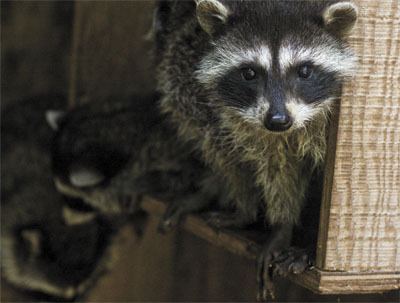During the summer, Wolf Hollow Rehabilitation Center resembles the emergency ward at a hospital. There is a room for x-rays and blood tests and quarters for injured “patients” that will be released as soon as they are healthy. Outside, a giant white board lists the types of patients currently in care at the center.
“It changes all the time,” said Shona Aitken, Wolf Hollow’s education coordinator. “It’s baby season, that’s why we have so many animals right now.”
But, unlike a hospital, the white board describes ducklings, seal pups, bald eagles, raccoon kits, baby minks and finches instead of listing patients in need of an appendectomy or tonsillectomy. And unlike the ER, volunteers, staff and interns busy themselves with tasks like feeding the seal pups or slicing up fresh roadkill or examining an injured songbird.
Aitken said it takes two full-time staff, two seasonal staff, five interns and on any given day one to two volunteers to run the center during these busy months.
Wolf Hollow, located on San Juan Island, has served San Juan and Skagit County for the past 30 years. The 40-acre property hosts 40 animal enclosures, including an eagle flight enclosure seal pools, a deer enclosure, and a songbird aviary.
So far this year, Wolf Hollow has treated 435 animals. Some are with Wolf Hollow for only a few days, while others need care for several months.
One recent case was a seal pup found on Orcas Island with bloody puncture wounds on its head. It joined several other pups, who spend their days bobbing around the center’s pool, poking their heads out of the water to stare curiously with black, bright eyes at their surroundings.
“These pups will be released in small groups when they get up to normal weaning weight [50 pounds] in the wild,” Aitken said.
In a small room across from the pools is the seal pup nursery. There are no baby rattles or pink mobiles dangling from the ceiling. Instead there are several bath tubs with wooden tops that do actually resemble the walls of a crib.
When the two pups, now in the pool, first came to Wolf Hollow, they spent every night tucked into these tubs because they were too weak or sick to swim all day, said Aitken. As they became stronger they could swim for a few hours each day. Now that they are in good health they stay in the water for 24 hours and eat fish on their own off the bottom of the pool.
Beyond the nursery is 40 acres with numerous cages tucked into heavily wooded areas, so the creatures feel at home while they recover from their injuries. A young bald eagle stands in the corner of his cage like a man with a large cloak wrapped around his shoulders. When the eagle gets healthier he will be moved to the flight cage, a 140-foot-long and 20-foot-high enclosure that will help him get back to the air. The flight cage is a unique structure because it is built at an angle, allowing for birds to practice turning in air, said Aitken.
Another cage quite a distance away is home to several young mallard ducks, who will be released when their flight feathers grow in.
“So they can get away from predators,” Aitken said.
And beyond that there’s the raccoon cage where seven fuzzy black and white faces crouch together.
Some people may not like the idea of the center rehabilitating animals that are in an over abundance on the islands like deer, raccoons and rabbits, but Aitken said Wolf Hollow doesn’t discriminate when it comes to the animals they treat.
Only a few animals have suffered injuries that have left them unable to return to the wild – a rough-legged and red-tailed hawk are used as education animals at schools and summer camps. As education coordinator, Aitken’s job is to help people learn more about local wildlife and human impacts on these animals and their habitats.
Aitken hopes the animals at Wolf Hollow may inspire people to “just simply be aware.”
For instance, cutting down a tree during nesting season may cause unnecessary songbird deaths or injuries when it is easy to cut down a tree in the fall or winter, she said.
She also wants people to know that Wolf Hollow is there when you need them.
“Maybe their cat brings in a songbird, their dog chases and injures a baby raccoon, a small hawk flies into their window or a they hit an owl when they are driving home one night,” said Aitken. “They then realize that we provide a service not just to the wild animals, but also to the people in the local community.”
For more info, visit http://wolfhollowwildlife.org.




